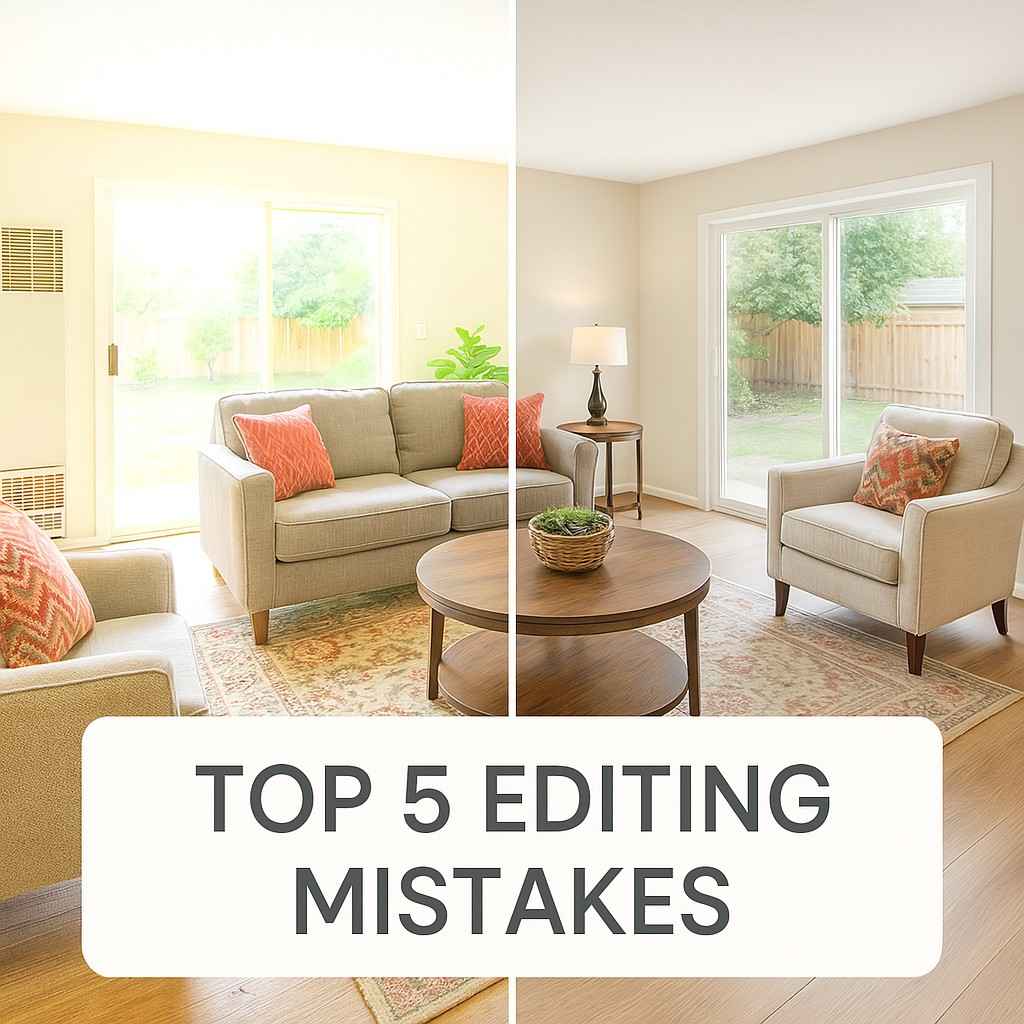Top 5 Mistakes to Avoid in Real Estate Photo Editing
Mistakes to avoid in real estate photo editing refer to common errors made during the process of enhancing property images. These mistakes can reduce the quality and effectiveness of photos used in listings, marketing materials, and online platforms. In today’s competitive real estate market, high-quality images are crucial for attracting potential buyers and showcasing properties accurately. Understanding these pitfalls helps professionals produce clear, appealing visuals that support successful sales. Recognizing the importance of mistakes to avoid in real estate photo editing is essential for real estate agents, photographers, and marketers aiming to maintain professional standards and improve property presentation.
Common Mistakes to Avoid in Real Estate Photo Editing
In the real estate industry, photo editing plays a crucial role in showcasing properties effectively. However, mistakes to avoid in real estate photo editing can negatively impact the appeal and accuracy of images. Poor editing may misrepresent the property, confuse potential buyers, or reduce the overall professionalism of listings. Understanding common pitfalls helps real estate professionals, photographers, and editors maintain high-quality visuals that support better marketing outcomes.

Why Real Estate Photo Editing Matters
Real estate photo editing involves enhancing images to highlight the property’s best features while maintaining an accurate representation. The process includes adjusting lighting, correcting colors, removing unwanted objects, and improving image clarity. Proper editing ensures photos look appealing on websites, brochures, and social media, attracting more interest from buyers and renters.
The use cases for real estate photo editing include:
- Online property listings
- Virtual tours and videos
- Marketing materials and flyers
- Agent websites and social media campaigns
Given its importance, avoiding common editing errors is essential for presenting properties professionally.
Key Mistakes to Avoid in Real Estate Photo Editing
Several common mistakes can reduce the effectiveness of real estate photos. Here are some of the most important things to watch for:
1. Over-Editing and Unrealistic Enhancements

Over-saturating colors, adding excessive contrast, or artificially brightening rooms can make photos look unnatural. This may lead to buyer disappointment when viewing the property in person.
2. Ignoring Image Distortion

Incorrect use of wide-angle lenses or poor perspective correction can distort room shapes and sizes, giving a misleading impression of space.
3. Poor Lighting Correction
Failing to balance shadows and highlights can result in dark or overly bright areas that hide important details or create distractions.
4. Neglecting Object Removal

Leaving unwanted items like trash, clutter, or reflections can distract viewers and reduce photo quality.
5. Inconsistent Editing Style
Using varying editing approaches across photos in the same listing can create an unprofessional and confusing visual experience.
Techniques to Improve Real Estate Photo Editing Quality

Applying correct photo editing techniques helps avoid these mistakes and enhances overall image quality. Common techniques include:
- Color Correction: Adjust white balance and saturation to ensure natural colors.
- Perspective Correction: Use lens correction tools to fix distortion and align vertical lines.
- Shadow and Highlight Adjustment: Balance exposure to reveal details in both dark and bright areas.
- Object Removal: Use cloning or healing tools to clean the scene without leaving traces.
- Consistent Editing Workflow: Apply similar adjustments across all photos for visual harmony.
✅ Pros and Cons Table
Real Estate Photo Editing: Common Practices
| Editing Practice | Pros ✔️ | Cons ❌ |
|---|---|---|
| ✅ Natural Color Correction | ✔️ Looks realistic ✔️ Highlights true beauty | ❌ Overdone can make rooms look dull |
| ✅ Perspective Correction | ✔️ Proper spatial understanding | ❌ Overcorrection may warp proportions |
| ✅ Object Removal | ✔️ Clean, distraction-free visuals | ❌ Poor removal can leave ghosting artifacts |
| ✅ Lighting Adjustments | ✔️ Balanced brightness ✔️ Better visibility | ❌ Too much can flatten image details |
| ✅ Consistent Style | ✔️ Professional look ✔️ Cohesive branding | ❌ Over-standardization can remove unique elements |
| ❌ Over-Editing | — | ❌ Misleading visuals ❌ Reduces buyer trust |
| ❌ Ignoring Distortion | — | ❌ Misrepresents room size and layout |
| ❌ Leaving Clutter in Frame | — | ❌ Distracts viewers ❌ Lowers professionalism |
| ❌ Uneven Editing Across Photos | — | ❌ Feels inconsistent and unprofessional |
The Role of Real Estate Photo Editing in Industry Success
High-quality images that avoid common editing mistakes support better engagement and higher property interest. Well-edited photos help buyers understand the space and features clearly, improving trust and reducing surprises during in-person visits. In a competitive market, avoiding these mistakes is key to maintaining professional standards and attracting serious buyers or renters.
FAQs: Common Questions About Real Estate Photo Editing Mistakes
1. What Are the Biggest Mistakes to Avoid in Real Estate Photo Editing?
✔️ Over-editing with unrealistic brightness or saturation
✔️ Leaving clutter or distracting objects in photos
✔️ Ignoring lens distortion or poor perspective
❌ Inconsistent editing styles across images
❌ Using heavy filters that mislead potential buyers
2. Why Is Real Estate Photo Editing So Important for Listings?
✔️ Attracts more clicks and inquiries
✔️ Showcases the property in its best light
✔️ Maintains visual consistency across marketing materials
❌ Poor editing can reduce trust and credibility
❌ Unedited or bad photos make listings look cheap
3. Does Over-Editing Photos Hurt Property Sales?
✔️ Slight enhancement improves appeal
❌ Over-saturation or brightness looks fake
❌ Misleading visuals create buyer disappointment
❌ It may lead to bad reviews or withdrawn offers
4. Can I Remove Objects from Real Estate Images?
✔️ Yes, removing wires, trash, or stains is acceptable
✔️ It improves focus on key features
❌ Don’t remove permanent elements like walls or appliances
❌ Misleading edits can result in legal issues or distrust
5. How Do I Keep a Consistent Editing Style Across Photos?
✔️ Use editing presets or templates in Lightroom or Photoshop
✔️ Apply similar adjustments (exposure, white balance, sharpness)
❌ Mixing editing styles confuses buyers
❌ Avoid extreme filters that make one room look warmer or cooler than others
6. What Software Do Professionals Use for Real Estate Photo Editing?
✔️ Adobe Lightroom – for batch processing and lighting correction
✔️ Adobe Photoshop – for advanced retouching and object removal
✔️ Luminar AI – for quick enhancements with AI tools
❌ Avoid basic smartphone apps—they lack control and precision
7. Is It Better to Edit Photos Myself or Hire a Professional?
✔️ DIY works if you have editing skills and tools
✔️ Outsourcing saves time and ensures consistency
❌ Bad DIY editing may hurt your brand image
❌ Lack of editing knowledge leads to common visual mistakes
8. Should I Use HDR in Real Estate Photography?
✔️ HDR helps balance bright windows and dark interiors
✔️ It reveals details in both highlights and shadows
❌ Overdone HDR looks unnatural
❌ Avoid ghosting effects from misaligned HDR images
Conclusion
Avoiding common mistakes in real estate photo editing is essential for producing clear, accurate, and professional images. This article highlighted key errors such as over-editing, image distortion, poor lighting correction, neglecting object removal, and inconsistent editing styles. Each of these can affect how a property is perceived by potential buyers or renters.
Understanding the importance of mistakes to avoid in real estate photo editing helps industry professionals maintain high standards in property presentation. By addressing these issues, real estate agents and photographers can ensure that images effectively showcase properties and support successful marketing efforts.
Suggested Reads from PixcRetouch Blog
- ✅ Why You Should Outsource Real Estate Photo Editing
Discover the benefits of outsourcing your edits—consistency, speed, and professional-grade results. - ✅ Clipping Path vs. Image Masking: Which One Do You Need?
Understand the best techniques for object and background removal—essential when removing distractions in property shots. - ✅ Background Removal vs. Clipping Path: What’s the Difference?
Learn which method is ideal for cleaning up cluttered real estate images, boosting clarity, and professionalism. - ✅ How to Improve Product Photos with Clipping Path Services
Though focused on product photography, the clipping path insights here also apply to architectural details and feature highlights. - ✅ Photo Enhancement Services with Pixc Retouch broad overview of enhancement techniques—lighting, color correction, retouching—that translate directly to real estate photo needs.




